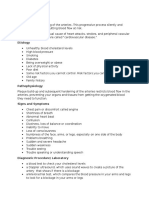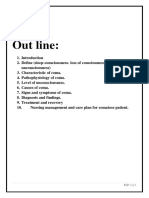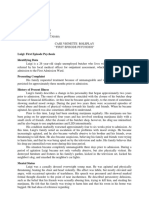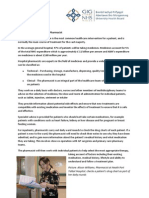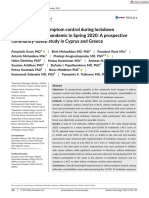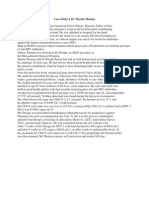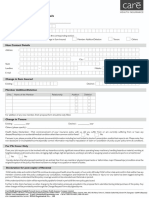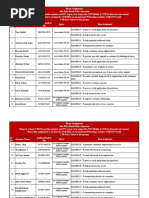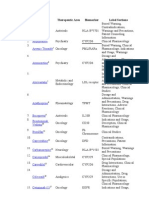Myocardial Infarction: Signs and Symptoms
Myocardial Infarction: Signs and Symptoms
Uploaded by
Kelly OstolCopyright:
Available Formats
Myocardial Infarction: Signs and Symptoms
Myocardial Infarction: Signs and Symptoms
Uploaded by
Kelly OstolOriginal Title
Copyright
Available Formats
Share this document
Did you find this document useful?
Is this content inappropriate?
Copyright:
Available Formats
Myocardial Infarction: Signs and Symptoms
Myocardial Infarction: Signs and Symptoms
Uploaded by
Kelly OstolCopyright:
Available Formats
Myocardial infarction
Myocardial infarction is the technical name for a heart attack. A heart attack occurs when an artery leading to the heart becomes completely blocked and the heart doesnt get enough blood or oxygen, causing cells in that area of the heart to die (called an infarct). Signs and Symptoms:
Squeezing pain, heaviness, tightness, pressure in center of chest Pain that spreads to your back, left arm, jaw, neck Shortness of breath Dizziness, weakness Nausea, vomiting Irregular heartbeat Sweating Feeling of doom
Women may experience different symptoms than men. In women, along with chest pain, symptoms can include:
Heartburn or pain in the abdomen Unusual fatigue Clammy skin
Causes: Heart attacks happen when an artery supplying your heart with blood becomes blocked. Without blood, the heart doesnt get enough oxygen and cells in the heart start to die. The most common cause of blocked arteries is atherosclerosis. No one knows the exact cause of atherosclerosis, but most researchers believe it begins with an injury to the innermost layer of the artery, known as the endothelium. The following factors are thought to contribute to the damage:
High blood pressure Elevated LDL ("bad") cholesterol An accumulation of homocysteine (an amino acid produced by the human body, thought to be a risk factor for heart disease, stroke, osteoporosis, diabetes, and dementia) Smoking
Diabetes Inflammation
Once the artery is damaged, blood cells called platelets build up there to try and repair the injury. Over time, fats, cholesterol, and other substances also build up at the site, which thickens and hardens the artery wall. The amount of blood that flows through the artery is decreased, and oxygen supply to organs also decreases. Blood clots may also form, blocking the artery. Rarely, a spasm in a coronary artery (one that supplies blood to the heart) stops blood flow and can cause a heart attack.
Pathophysiology
Diagnostic exam:
Electrocardiogram (ECG) -- the first test done to check for a heart attack. You may be hooked up to a monitor even as the doctor is asking you questions. An ECG measures electrical activity of your heart. Blood tests -- Your doctor may look for certain enzymes that are released into your blood when you have a heart attack.
Other tests include:
Chest x-ray Echocardiogram (uses sound waves to take a picture of your heart) Coronary catheterization or angiogram (uses a liquid dye inserted through a catheter to see whether your arteries are blocked) Stress test (involves walking on a treadmill while hooked up to an ECG machine to see how your heart responds to exercise)
Treatment
Lifestyle
Making lifestyle changes can improve many of your risk factors for heart disease, including high cholesterol, high blood pressure, extra weight, high homocysteine, and elevated C-reactive protein. Cardiac rehabilitation programs generally involve teaching you about diet, physical activity, and relaxation techniques. To keep your risk factors low, you will need to follow the healthy habits taught in cardiac rehab, such as exercise and eating properly, for the rest of your life.
Medications
When you arrive at the hospital, you will likely be given one or more medications to help your body cope with, or ward off, damage from the heart attack, including:
Aspirin - helps stop blood from clotting. You may be given aspirin in the ambulance or as soon as you get to the hospital. Aspirin should be continued indefinitely at a dose of 81 mg per day.
Nitroglycerin - helps dilate (widen) blood vessels. You may be given nitroglycerin in the ambulance or as soon as you get to the hospital. Pain reliever - helps relieve pain and is often given intravenously (IV). Thrombolytic -a work to break up clots. A They are most effective when taken within 2 hours of the heart attack, and are not given after 12 hours have elapsed. These drugs may be given with other anticoagulants (blood thinners). Anticoagulants (blood thinners) -- make your blood less likely to form clots. Heparin is often given by injection while you are in the hospital.
Preventive Care: You can reduce your risk of heart attack by:
Stopping smoking. Getting aerobic exercise (such as walking, biking, or swimming) for at least 30 minutes 5 days per week. If you haven't exercised much in the past, walking is a great way to start. If you have any heart risk factors, you should get an okay from your health care provider that you're healthy enough to begin an exercise program. Reducing stress and learning stress-reduction techniques such as deep breathing and meditation. Yoga and tai chi -- two forms of exercise that emphasize stretching, breathing, and meditating -- can also help you reduce your stress level. Eating a diet low in saturated fat and rich in fruits, vegetables, and whole grains. Losing weight or maintaining a proper weight.
If you have high cholesterol, diabetes, or high blood pressure, follow your doctors instructions to keep these risk factors under control. You may need medications in addition to lifestyle changes. If you don't have heart disease yet or have not had a heart attack despite these risk factors, aggressive control can help prevent a heart attack. And, if you already have heart disease, aggressive control of these risk factors can prevent further heart attacks or other problems related to heart disease. Nursing intervention Administer analgesics as ordered. Organize patient care and activities to allow periods of uninterrupted rest. Provide a clear liquid diet until nausea subsides. Provide stool softener to prevent straining during defecation. Assist with range of motion exercises. Provide emotional support, and help reduce stress and anxiety.
Assess and record the patients severity, location, type, and duration of pain. Check his blood pressure after giving nitroglycerin, especially during first dose. Thoroughly explain the medication and treatment regimen. Review dietary restriction with the patient. Advise the patient about appropriate responses to new or recurrent symptoms. Stress the need to stop smoking.
You might also like
- Peripheral Artery Disease: Nikhil Vaishnav M.Sc. (Nursing)Document70 pagesPeripheral Artery Disease: Nikhil Vaishnav M.Sc. (Nursing)Dimpal ChoudharyNo ratings yet
- Definition of Transfusion ReactionDocument26 pagesDefinition of Transfusion ReactionAlvin A. AldeaNo ratings yet
- AtherosclerosisDocument2 pagesAtherosclerosisJarelle Guinto Roman100% (1)
- A Simple Guide to Circulatory Shock, Diagnosis, Treatment and Related ConditionsFrom EverandA Simple Guide to Circulatory Shock, Diagnosis, Treatment and Related ConditionsNo ratings yet
- Cardiac Tamponade, A Simple Guide To The Condition, Diagnosis, Treatment And Related ConditionsFrom EverandCardiac Tamponade, A Simple Guide To The Condition, Diagnosis, Treatment And Related ConditionsNo ratings yet
- Cardiac Arrest, A Simple Guide To The Condition, Diagnosis, Treatment And Related ConditionsFrom EverandCardiac Arrest, A Simple Guide To The Condition, Diagnosis, Treatment And Related ConditionsNo ratings yet
- Cardiac TamponadeDocument10 pagesCardiac TamponadeRahmi Fatma SariNo ratings yet
- Heart Muscle Shortness of Breath Tired Swelling of The Legs Heart Failure Irregular Heart Beat Fainting Sudden Cardiac DeathDocument6 pagesHeart Muscle Shortness of Breath Tired Swelling of The Legs Heart Failure Irregular Heart Beat Fainting Sudden Cardiac DeathSachin DwivediNo ratings yet
- Mounika G1Document8 pagesMounika G1pandem soniyaNo ratings yet
- Case StudyDocument7 pagesCase StudyBiway RegalaNo ratings yet
- Malabsorption Syndrome Malaika NaseerDocument10 pagesMalabsorption Syndrome Malaika NaseerEntertainment MoviesNo ratings yet
- Thyroid CrisisDocument11 pagesThyroid CrisisKoka KolaNo ratings yet
- Care of ComaDocument14 pagesCare of ComaAhmed Fahmy100% (1)
- Asthma: A. DefinitionDocument6 pagesAsthma: A. DefinitionElvando SimatupangNo ratings yet
- Cerebrovascular AccidentDocument30 pagesCerebrovascular AccidentJaydee Dalay100% (2)
- Assessment of The Genitourinary System: GeneralDocument2 pagesAssessment of The Genitourinary System: GeneralMaharani UtamiNo ratings yet
- Caronary Artery Disease & Congestive Heart Failure: Margaret Xaira R. Mercado RNDocument32 pagesCaronary Artery Disease & Congestive Heart Failure: Margaret Xaira R. Mercado RNMargaret Xaira Rubio MercadoNo ratings yet
- Cardiac AssessmentDocument48 pagesCardiac AssessmentRatheesh NathNo ratings yet
- Portal HypertensionDocument23 pagesPortal HypertensionSumathi Gopinath100% (1)
- Kano State College of Nursing and Midwifery: Cardiac ArrestDocument4 pagesKano State College of Nursing and Midwifery: Cardiac ArrestMuhammad Daha SanusiNo ratings yet
- Cardiac Enzyme StudiesDocument4 pagesCardiac Enzyme StudiesDara VinsonNo ratings yet
- Unstable Angina PectorisDocument34 pagesUnstable Angina PectoriserinmowokaNo ratings yet
- Heart Disease Teaching PlanDocument16 pagesHeart Disease Teaching Planapi-554096544No ratings yet
- Antianginal DrugsDocument14 pagesAntianginal DrugsDRABHIJITNo ratings yet
- Otitis MediaDocument9 pagesOtitis MediaMona Santi NainggolanNo ratings yet
- ArrhythmiasDocument48 pagesArrhythmiasHarshan JeyakumarNo ratings yet
- Cardiogenic ShockDocument6 pagesCardiogenic ShockhamadaelgenNo ratings yet
- Head Injury NoteDocument7 pagesHead Injury NoteAi Mio100% (1)
- Valvular Heart DiseaseDocument2 pagesValvular Heart DiseaseAnonymous TVk12eX4No ratings yet
- Case Study On Lung CancerDocument54 pagesCase Study On Lung CancerQusai BassamNo ratings yet
- Valve SurgeriesDocument13 pagesValve SurgeriesShreeja SajitNo ratings yet
- Cardiac Dysrhythmias: Mrs. D. Melba Sahaya Sweety M.SC Nursing GimsarDocument60 pagesCardiac Dysrhythmias: Mrs. D. Melba Sahaya Sweety M.SC Nursing GimsarD. Melba S.S Chinna100% (1)
- Chronic Obstructive Pulmonary Disease COPDDocument25 pagesChronic Obstructive Pulmonary Disease COPDKat OrtegaNo ratings yet
- Angina PectorisDocument33 pagesAngina PectorisRosse Del MundoNo ratings yet
- Prevention of Deep Vein ThrombosisDocument11 pagesPrevention of Deep Vein ThrombosisSindhuja vivekanandhanNo ratings yet
- Terminology Causes of Cardiac Arrest C.P.R. For The Adult, Child & Baby Stroke & Stroke ManagementDocument28 pagesTerminology Causes of Cardiac Arrest C.P.R. For The Adult, Child & Baby Stroke & Stroke Managementbusiness911No ratings yet
- Cerebrovascular Accident (CVA)Document71 pagesCerebrovascular Accident (CVA)nur muizzah afifah hussin100% (1)
- PacemakerDocument13 pagesPacemakeralainzkie100% (2)
- Myocardial InfarctionDocument43 pagesMyocardial InfarctiondeeptiNo ratings yet
- Cardiovascular System Diseases Part 2Document9 pagesCardiovascular System Diseases Part 2Prince Rener Velasco PeraNo ratings yet
- Thrombolytic TherapyDocument16 pagesThrombolytic TherapyAnonymous nrZXFwNo ratings yet
- Unconsciousness: Anil PatidarDocument29 pagesUnconsciousness: Anil Patidarjinal sutharNo ratings yet
- Infective EndocarditisDocument66 pagesInfective Endocarditissanjivdas100% (4)
- Pericarditis NCLEX Review: Serous Fluid Is Between The Parietal and Visceral LayerDocument2 pagesPericarditis NCLEX Review: Serous Fluid Is Between The Parietal and Visceral LayerlhenNo ratings yet
- Systemic Inflammatory ResponseDocument2 pagesSystemic Inflammatory Responsesmithaanne20016923No ratings yet
- Raynauds DiseaseDocument13 pagesRaynauds Diseaseapi-3718174100% (3)
- Myocardial InfarctionDocument18 pagesMyocardial Infarctionporing500No ratings yet
- StomachGastricCancerDocument12 pagesStomachGastricCancerBhawna JoshiNo ratings yet
- Heart TransplantationDocument10 pagesHeart TransplantationNajmi Leila SepyanisaNo ratings yet
- Post Resus CareDocument35 pagesPost Resus Caredrjaikrish100% (1)
- CARDIAC Invasive Procedures FinalDocument19 pagesCARDIAC Invasive Procedures FinalSimran JosanNo ratings yet
- Mitral StenosisDocument2 pagesMitral StenosisKing Bal94No ratings yet
- Introduction Definition: Types of PacemakersDocument8 pagesIntroduction Definition: Types of PacemakersPrasann RoyNo ratings yet
- Pulmonary EdemaDocument14 pagesPulmonary EdemaRizzamwah Catague100% (1)
- Cardiovascular System Diseases Part 1Document22 pagesCardiovascular System Diseases Part 1Prince Rener Velasco PeraNo ratings yet
- Pulmonary Function TestsDocument2 pagesPulmonary Function TestsSafuan Sudin100% (1)
- Pleural DiseasesDocument52 pagesPleural DiseasesAmolkumar W DiwanNo ratings yet
- Continuous Renal Replacement TherapyDocument38 pagesContinuous Renal Replacement Therapyanju rachel joseNo ratings yet
- Coronary Artery DiseaseDocument9 pagesCoronary Artery DiseaseRantini Indrayani100% (1)
- Part I: IntroductionDocument4 pagesPart I: IntroductionChezka PalolaNo ratings yet
- Ebstein Anomaly, A Simple Guide To The Condition, Diagnosis, Treatment And Related ConditionsFrom EverandEbstein Anomaly, A Simple Guide To The Condition, Diagnosis, Treatment And Related ConditionsNo ratings yet
- Case Vignette RoleplayDocument4 pagesCase Vignette RoleplayNadira Juanti Pratiwi0% (1)
- Graduate Nurse Resume ExampleDocument2 pagesGraduate Nurse Resume ExampleTitin Paramida100% (1)
- Day in The Life of A Pharmacist PDFDocument3 pagesDay in The Life of A Pharmacist PDFjoanne_rawksNo ratings yet
- Chapter 15 - Multiple ChoiceDocument12 pagesChapter 15 - Multiple ChoiceNicky PhakathiNo ratings yet
- MT102 ReviewerDocument5 pagesMT102 ReviewerLuke Aaron GoticoNo ratings yet
- Article Ejbps Volume 3 December Issue 12 1480826682Document4 pagesArticle Ejbps Volume 3 December Issue 12 1480826682yenni anggrainiNo ratings yet
- TB Skin Diseases QuizDocument3 pagesTB Skin Diseases QuizCherlane KasekNo ratings yet
- Principles and Practice of Travel Medicine - 2001 - ZuckermanDocument36 pagesPrinciples and Practice of Travel Medicine - 2001 - ZuckermanriscaNo ratings yet
- 5 Forensic MedicineDocument16 pages5 Forensic MedicineRoman Al MamunNo ratings yet
- Pediatric Pulmonology - 2021 - Kouis - Pediatric Asthma Symptom Control During Lockdown For The COVID 19 Pandemic in SpringDocument9 pagesPediatric Pulmonology - 2021 - Kouis - Pediatric Asthma Symptom Control During Lockdown For The COVID 19 Pandemic in SpringFuerza Dedicacion OmegaNo ratings yet
- Right at Home Featured in Zillion MagazineDocument1 pageRight at Home Featured in Zillion MagazineNo LimitNo ratings yet
- The Case of Martin ThomasDocument2 pagesThe Case of Martin Thomascfournier1982No ratings yet
- Postoperative Care in MedicalDocument5 pagesPostoperative Care in MedicalMark Russel Sean LealNo ratings yet
- Infographics WK5, Sanjose, CherryjoyDocument2 pagesInfographics WK5, Sanjose, CherryjoySanjose CherryjoyNo ratings yet
- Diseases of The Conjuctiva IIDocument37 pagesDiseases of The Conjuctiva IILydiah kawiraNo ratings yet
- The Management of Pressure Ulcers in Primary and Secondary Care PDFDocument464 pagesThe Management of Pressure Ulcers in Primary and Secondary Care PDFDragos-Ronald RugescuNo ratings yet
- CHANGE REQUEST FORM With NCD-20200909164219Document2 pagesCHANGE REQUEST FORM With NCD-20200909164219Ajijur Rahman0% (1)
- Pengaruh Restrain Pada Pasien Perilaku Kekerasan Terhadap Penurunan Perilaku Kekerasan Di Ruang Igd RSJD Atma Husada Mahakam SamarindaDocument8 pagesPengaruh Restrain Pada Pasien Perilaku Kekerasan Terhadap Penurunan Perilaku Kekerasan Di Ruang Igd RSJD Atma Husada Mahakam SamarindaAyu Diah Sri Krisnayanti PutuNo ratings yet
- Ipi 478563Document7 pagesIpi 478563abdulrozakNo ratings yet
- ISCR - Data Sharing and Anonymization - Virtua Workshop Flyer - 06sep2021Document2 pagesISCR - Data Sharing and Anonymization - Virtua Workshop Flyer - 06sep2021brain_teaserNo ratings yet
- Насадки на скалерDocument127 pagesНасадки на скалерІрина Лазарчук100% (1)
- Medical - BUPA Info BookletDocument31 pagesMedical - BUPA Info BookletAnonymous hRWwL7pZnCNo ratings yet
- Facilitating The Birth of The PlacentaDocument6 pagesFacilitating The Birth of The PlacentaLatasha GonzalezNo ratings yet
- CMS Manual System: Pub 100-03 Medicare National Coverage DeterminationsDocument11 pagesCMS Manual System: Pub 100-03 Medicare National Coverage DeterminationsKamalakar ReddyNo ratings yet
- A Cost-Consequence Analysis ofDocument10 pagesA Cost-Consequence Analysis ofviviana benavidesNo ratings yet
- ScoliosisDocument4 pagesScoliosisDharline Abbygale Garvida AgullanaNo ratings yet
- Retail Sales Associate - Home AssignmentDocument4 pagesRetail Sales Associate - Home AssignmentPankaj TiwaryNo ratings yet
- Abacavir: Nr. Drug Therapeutic Area Biomarker Label SectionsDocument7 pagesAbacavir: Nr. Drug Therapeutic Area Biomarker Label SectionsDiana TararacheNo ratings yet
- Focus Final Project: Healthy Lifestyle: More Than A Summer Project, A LifestyleDocument8 pagesFocus Final Project: Healthy Lifestyle: More Than A Summer Project, A LifestyleFrancimar OliveiraNo ratings yet


